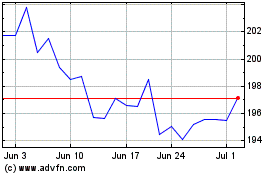U.S. 2-Year Government Bond Yield at 10-Month High, Above 1% on Retail Sales
November 15 2016 - 4:21PM
Dow Jones News
By Min Zeng
The yield on the two-year Treasury note closed above 1% on
Tuesday for the first time in 10 months, as fresh signs of robust
consumer spending boosted market expectations for a Federal Reserve
interest rate increase next month.
The yield on the two-year note closed at 1.008%, up from 0.988%
on Monday. Yields rise as bond prices fall. Yields on short-term
debt are highly sensitive to the Fed's policy outlook.
The yield on the benchmark 10-year Treasury note closed at
2.240%, compared with 2.224% Monday. It was the highest close level
since Jan 5.
The winner on Tuesday was the 30-year bond, with its yield
falling to 2.972% from 2.983%. Traders said long-term bonds
benefited from investors migrating cash out of short-term debt, a
popular allocation strategy to prepare for the Fed's tightening
monetary policy.
Retail sales rose 0.8% in October from the prior month,
following 1% gain in September, the Commerce Department said on
Tuesday. Those gains marked the best two-month stretch of sales in
at least two years, boosting sentiment about the U.S. growth
outlook.
Federal Reserve Bank of Boston President Eric Rosengren on
Tuesday said a December interest-rate increase looks pretty likely
at this point. Fed-funds futures, a popular derivative market for
hedge funds and money managers to place bets on the U.S. interest
rate policy outlook, suggested a 91% probability of a rate increase
by the Fed's December meeting, according to data from CME Group.
The odds were 86% Monday and 81% late last week.
Selling pressure in the bond market was moderate on Tuesday, a
tentative sign that the bond market rout that had intensified since
last week's U.S. presidential election may be subsiding.
Before Tuesday's session, the 10-year note's yield had been up
by more than 0.4 percentage point, marking the biggest five-day
rise since 2009. The yield was 1.867% on the election day. It hit
2.3% during Monday's session but has since pulled back from that
level.
"It is time to start buying at these yield levels," said Larry
Milstein, managing director of government and agency trading at
R.W. Pressprich & Co. He said the 10-year yield trading close
to 2.25% is a buying opportunity.
Like many others, Mr. Milstein expects more price swings in the
bond market, given the uncertain outlook over Mr. Trump's policy
and its efficacy. "We won't know the answer until we really see
what sort of infrastructure spending package and reduction in tax
rates are proposed, " he said.
Others say the bond market is vulnerable for a further increase
in yields.
Bond yields in the developed world have been rising after a big
drop this summer. The selling pressure had accelerated after Donald
Trump's surprise win to become the next U.S. president. Investors
have been shedding bond holdings as speculation has been growing
that his expansionary fiscal policy may lead to stronger growth and
higher inflation.
A brighter growth outlook makes government bonds, typically a
haven to preserve capital, less appealing to hold. Inflation chips
away bonds' fixed returns over time and is a big threat to
long-term government bonds.
"In the short term, it's hard to see yields falling back," said
John Stopford, head of multi-asset income at Investec Asset
Management, which had $115 billion assets under management at the
end of October. "If these fiscal policies are implemented and they
fail to boost growth, then we could see a retracement in the longer
term. For the moment, the market is giving it the benefit of the
doubt."
A bond-market sentiment gauge closely followed by global
investors was the most bearish on bond prices in 10 months.
The share of investors expecting higher bond prices fell to 11%
for the week ending Monday from 14% a week ago, according to the
latest weekly Treasury clients survey from J.P. Morgan Chase &
Co. released on Tuesday. The share of those expecting lower bond
prices rose to 23% from 16%. The resulting negative 12% difference
reflects the most negative sentiment on the bond market since Jan
25.
Global data over the past month have pointed to improvement in
manufacturing and an uptick in inflation pressure from China, the
U.K. and the U.S. A gauge of wage inflation in the U.S. rose at the
fastest pace last month since 2009.
Analysts say one risk for the bond market is that the Fed may
quicken its pace of tightening in 2017, which would put more
selling pressure on Treasury bonds.
Write to Min Zeng at min.zeng@wsj.com
(END) Dow Jones Newswires
November 15, 2016 16:06 ET (21:06 GMT)
Copyright (c) 2016 Dow Jones & Company, Inc.
CME (NASDAQ:CME)
Historical Stock Chart
From Mar 2024 to Apr 2024

CME (NASDAQ:CME)
Historical Stock Chart
From Apr 2023 to Apr 2024
